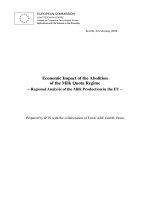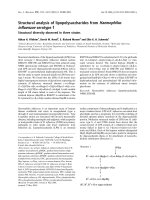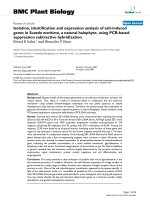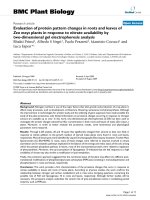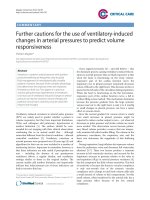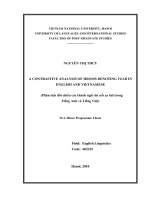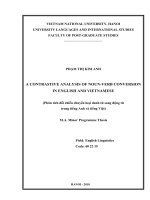Structural analysis of calcium induced changes in gelsolin and adseverin
Bạn đang xem bản rút gọn của tài liệu. Xem và tải ngay bản đầy đủ của tài liệu tại đây (5.25 MB, 159 trang )
STRUCTURAL ANALYSIS OF CALCIUM-INDUCED
CHANGES IN GELSOLIN AND ADSEVERIN
NAG SHALINI
NATIONAL UNIVERSITY OF SINGAPORE
2010
STRUCTURAL ANALYSIS OF CALCIUM-INDUCED
CHANGES IN GELSOLIN AND ADSEVERIN
NAG SHALINI
(B. Appl. Sc. (1
st
Class Hons.), NUS)
DEPARTMENT OF BIOLOGICAL SCIENCES
NATIONAL UNIVERSITY OF SINGAPORE
2010
i
Acknowledgements
Acknowledgement is due to so many people that it is almost impossible to mention them all
here. I have however, made a feeble attempt to thank those without whom this thesis would
not exist. I sincerely thank everyone who is mentioned here and everyone who isn’t but has
contributed in different and sometimes, intangible ways.
Bob, for making me part of your lab when you weren’t sure you wanted to, for reawakening
my interest in science and crystallography, for supporting, encouraging and teaching me, for
patiently answering my questions, for burning evening and weekend beers (and hours) to help
me finish my thesis on time – no thanks can suffice.
Dr. Swami, for introducing me to crystallography and giving me the opportunity to start my
Ph.D. Prof. Ding for giving me a decent foundation in molecular biology, protein expression
and purification. Dr. Pua, for my first opportunity to experience working in a lab. Wang Jing
and Liu Pei, for ensuring that I treat ethidium bromide and acrylamide and the like, with the
respect that they deserve, and ensuring that I am not an occupational hazard to my colleagues.
My collaborators, Les, Toomy, Hui Wang, Bala, for the structures, movies, images, editing
and advice that made the publications possible.
The BR lab - Alvin, for all the ultra-pure actin and for maintaining the screenmaker – without
them no other acknowledgements would have to be; Marten and Albert, for editing, more
editing, advisory and query-resolving services, and for the vectors; Wei Lin and Qing, for
teaching me so much for collaborating with me; Maria, for your invaluable advice; Khay
Chun and David, for all that I’ve learnt from our discussions and everyone else, for helping in
so many ways and generally providing good company and lots of fun.
My colleagues and friends – Karen and Shee Mei, I could never have done this without your
advice and encouragement; Linan, Danny, Kar Lai, Amanda, Vani, Sumana, Soah Yee, for all
the impromptu counselling sessions; Bala, Punitha, Sowmya, Akshay, Siddharth, Deepak,
Buvana, Dimple, Leslie, Annie, Ana, for keeping me from becoming clinically insane.
My family, for always being there for me – both as spring board and safety net.
Surya, for being my rudder, sail and anchor, whichever I needed most whenever I needed it –
I could never have reached this point without you.
ii
Table of Contents
Acknowledgements…………………………………………………………………………. i
Table of Contents………………………………………………………………………… ii
Summary…………………………………………………………………………………… vi
List of Tables……………………………………………………………………………… viii
List of Figures……………………………………………………………………………… ix
Abbreviations……………………………………………………………………………… xi
Chapter 1. Introduction……………………………………………………………………. 1
1.1 Introductory Remarks……………………………………………………………… 1
1.2 Actin – custom made cellular infrastructure………………………………………… 2
1.2.1 Actin functions in the cytoplasm……………………………….………… 3
1.2.2 Actin functions in the nucleus……………………………… …………… 5
1.2.3 In the X-ray beam – the structure of actin……………… ………………… 6
1.2.3.1 G-actin………………………………………… ………………… 6
1.2.3.2 F-actin……………………………………………………… …… 7
1.2.4 Actin dynamics………………………………….………………………… 9
1.2.5 Regulation of actin dynamics – The role of actin binding proteins………… 10
1.3 The gelsolin superfamily………………………………………………………….… 11
1.3.1 Overview…………………………………………………………………… 11
1.3.2 An introduction to gelsolin and its mammalian relatives………………… 14
1.3.3 Cellular functions of gelsolin family proteins………………………………. 18
1.3.4 Regulation of gelsolin family proteins……………………………………… 19
1.4 Gelsolin……………………………………………………………………………… 21
1.4.1 Key characteristics unique to gelsolin……………………………………… 21
1.4.2 Modular distribution of gelsolin functions………………………………… 22
1.4.3 Molecular gymnast, crystallographer’s bane – conformational antics
of gelsolin…………………………………………………………………… 23
iii
1.4.3.1 Structure of inactive gelsolin………………………………………. 24
1.4.3.2 Structure of the active C-terminal half of gelsolin………………… 24
1.4.3.3 Structure of the active N-terminal half of equine plasma gelsolin…. 26
1.5 F-actin severing by gelsolin…………………………………………………………. 27
Chapter 2. Materials and Methods……………………………………………………… 30
2.1 Materials…………………………………………………………………………… 30
2.2 Methods…………………………………………………………………………… 32
2.2.1 Cloning and construct preparation………………………………………… 32
2.2.1.1 Vectors used……………………………………………………… 32
2.2.1.2 Strains and culture conditions……………………………………… 35
2.2.1.3 Cloning of scinlA and scinlB………………………………………. 35
2.2.1.4 Site-directed mutagenesis………………………………………… 35
2.2.2 Protein expression and purification…………………………………………. 35
2.2.2.1 Gelsolin and calcium-binding mutants, scinderin-like A,
scinderin-like B…………………………………………………… 35
2.2.2.2 Gelsolin G2-G3…………………………………………………… 36
2.2.3 Analysis of protein purity………………………………………………… 37
2.2.4 Dynamic light scattering……………………………………………………. 38
2.2.5 Functional assays…………………………………………………………… 38
2.2.5.1 Actin depolymerization assay……………………………………… 38
2.2.5.2 Actin monomer sequestration assay……………………………… 40
2.2.5.3 Actin filament nucleation assay……………………………………. 40
2.2.6 Preparation of protein complexes………………………………………… 41
2.2.7 Crystallization………………………………………………………………. 41
2.2.8 Data collection……………………………………………………………… 42
2.2.9 Structure solution, refinement and analysis………………………………… 42
2.2.9.1 Human G1-G3/actin complex……………………………………… 42
2.2.9.2 Calcium-bound human G3…………………………………………. 43
iv
2.2.9.3 Zebrafish scinderin-like B…………………………………………. 43
Chapter 3. Calcium activation of gelsolin – Part I……………………………………… 45
3.1 Background………………………………………………………………………… 45
3.2 Results………………………………………………………………………………. 48
3.2.1 3 Å structure of the N-terminal half of human gelsolin in complex
with actin……………………………………………………………………. 48
3.2.1.1 Description of human G1-G3/actin structure………………………. 48
3.2.1.2 Comparison with the structure of calcium-bound equine
G1-G3/actin………………………………………………………… 51
3.2.1.3 Comparison with the structure of cadmium-bound G2…………… 51
3.2.2 1.2 Å structure of activated G3 in isolation………………………………… 53
3.2.2.1 Preparation and characterization of G2-G3………………………… 53
3.2.2.2 Data collection, modeling and refinement of G3………………… 54
3.2.2.3 The structure of active gelsolin domain 3 in isolation…………… 54
3.2.2.4 Comparison with active G3 from the G1-G3/actin structure………. 56
3.2.2.5 Comparison with inactive G3………………………………………. 57
3.3 Discussion…………………………………………………………………………… 59
Chapter 4. Calcium activation of gelsolin – Part II………………………………………. 66
4.1 Background………………………………………………………………………… 66
4.2 Results………………………………………………………………………………. 68
4.2.1 Preparation of gelsolin calcium-binding site mutants………………………. 68
4.2.2 Actin depolymerization assay – an assay for studying the roles of the
type-II calcium-binding sites of gelsolin…………………………………… 68
4.2.3 G2 and G6 calcium-binding sites contribute to gelsolin activity…………… 71
4.2.4 Different domains of gelsolin may have conflicting roles………………… 74
4.2.5 GQMG4G5 has activity comparable to GTL……………………………… 77
4.2.6 Six-site mutants can deploymerize actin to the same extent as activated
GFL…………………………………………………………………………. 79
4.2.7 The six-site gelsolin mutants sequester monomers but do not nucleate
filaments…………………………………………………………………… 79
v
4.3 Discussion…………………………………………………………………………… 82
Chapter 5. Adseverin and scinderin-like B offer insights into the structure,
function and regulation of the gelsolin family……………………………… 89
5.1 The adseverin C-terminal half imitates the structure and actin binding
mechanism of gelsolin……………………………………………………………… 89
5.1.1 Background – Adseverin and gelsolin: homologous sequences, variable
function and regulation…………………………………………………… 89
5.1.2 Results……………………………………………………………………… 92
5.1.2.1 Actin-binding by adseverin mirrors actin-binding by gelsolin…… 92
5.1.2.2 Adseverin A5-A6 is unable to nucleate actin filaments……………. 92
5.1.2.3 The N-terminal half confers calcium regulation on adseverin…… 94
5.2 The structure of calcium-free scinderin-like B……………………………………… 95
5.2.1 Background – Divergent sequences, novel functions – scinderin-like
genes from zebrafish……………………………………………………… 95
5.2.2 Results……………………………………………………………………… 96
5.2.2.1 Sequence comparison of scinlA and scinlB with adseverin
and gelsolin………………………………………………………… 96
5.2.2.2 Protein preparation and crystallization…………………………… 96
5.2.2.3 Actin-related functions of zebrafish scinderin-like genes………… 96
5.2.2.4 Structural data for scinlB………………………………………… 99
5.2.2.5 Structure of inactive scinlB………………………………………… 101
5.2.2.6 Comparative study of the scinlB domains…………………………. 105
5.2.2.7 Comparative analysis of individual domains of scinlB and
gelsolin…………………………………………………………… 105
5.2.2.8 Towards the structure of scinlB/actin………………………………109
5.3 Discussion……………………………………………….………………………… 109
Chapter 6. Perspectives and Conclusions…………………………………………………. 119
6.1 Matters arising – insights and questions………………………………………… 119
6.2 Future Work…………………………………………………………………………. 125
References…………………………………………………………………………………. 128
Appendices………………………………………………………………………………… 144
vi
Summary
The actin cytoskeleton is a dynamic machine that constantly undergoes rearrangements
to perform diverse cellular functions, which range from powering movement to providing
mechanical strength and shape. Actin function is regulated by numerous actin-binding
proteins (ABPs) that modulate its polymerization kinetics and interactions with other cellular
components. The gelsolin superfamily of calcium-dependent ABPs, are multifunctional
regulators of actin dynamics that participate in numerous cellular processes. Calcium binding,
to the six conserved type-II sites, activates gelsolin by inducing large structural
rearrangements that expose the actin-binding sites. Gelsolin can then bind monomeric actin or
sever, cap and nucleate filaments. However, the mechanisms through which calcium binding
is translated into large domain movements, and the contribution of the individual type-II sites,
remain unclear.
This thesis describes the structures of the actin-bound N-terminal half (G1-G3) and
active domain-3 (G3) of human cytoplasmic gelsolin. These data, in combination with the
functional characterization of calcium-binding site mutants of gelsolin, provide insights into
gelsolin activation. Release of the C-terminal tail-latch partially activates gelsolin, by
allowing it to dynamically shift between open and closed conformations, and appears to be
one of the early steps of activation. Cooperative binding of calcium to domains 2 (G2) and 6
(G6) mediates tail-latch release by inducing localized structural changes, possibly resulting in
clashes that push these two domains apart. Cooperative binding of calcium to G2, G4 and G6
or G2, G5 and G6, appear to activate the C-terminal half of gelsolin (G4-G6) by springing the
G4-G6 latch in addition to the tail-latch.
The role of the gelsolin mutations, studied here, has relevance for familial amyloidosis
of the Finnish-type (FAF). The G2 mutation causing FAF was observed to be activating at
low calcium concentrations and had a destabilizing effect at high calcium concentrations.
Thus, mutant gelsolin possibly gets trapped in intermediate conformations where the furin
cleavage site is exposed and gets cleaved into the deposit-forming fragments.
vii
The functional characterization studies of adseverin, presented here, suggest that the
C-terminal half of human adseverin (A4-A6) is indistinguishable from that of G4-G6, placing
the major actin-binding site of A4-A6 within A4. A5-A6 lacks any ability to nucleate actin
polymerization. However, while the isolated G1-G3 has calcium-independent activity, the
adseverin N-terminal half (A1-A3) must bind calcium to function, thus explaining why
adseverin is inactive in the absence of calcium, despite the lack of the C-terminal tail-latch. It
appears that calcium-independent activity of isolated G1-G3 may be attributed to
conformational changes induced by the binding of actin to G2 and the straightening of the G3
helix and AB loops.
Finally, the structure of calcium-free full-length zebrafish scinderin-like B (scinlB)
was elucidated and observed to be broadly similar to the structure human gelsolin. However,
despite being calcium-free, the structure of scinlB appears to be in an early activation stage,
possibly because it crystallized at a semi-activating pH. This structure suggests that calcium-
and pH-dependent activation may share some common mechanisms, and also offers an
avenue for elucidating pH-mediated activation of gelsolin family proteins.
Hence, this study has elucidated some of the mechanisms involved in calcium-
activation of gelsolin-family members, delineated the roles of the G2, G4, G5 and G6 type-II
calcium-binding sites in activation, highlighted the functional similarities and differences
between gelsolin and adseverin, and provided avenues for further exploration of the roles and
functions of the other gelsolin calcium-binding sites as well as the mechanisms of pH
activation.
viii
List of Tables
Table 1.1 Some human ABPs with an example of their functions……………… 12
Table 2.1 Reagents used in this study…………………………………………… 30
Table 2.2 Oligonucleotides/primers used in this study…………………………… 30
Table 3.1 Statistics for G1-G3/actin………………………………………………. 49
Table 3.2 Data collection and refinement statistics for calcium-bound G3…… 55
Table 4.1 Gelsolin mutants used in this study……………………………………. 69
Table 5.1 Data collection and refinement statistics for scinderin-like B (ScinlB) …. 101
Table 5.2 Structural variations between scinlB and gelsolin domains………………107
ix
List of Figures
Figure 1.1 Micrographs of actin filament structures in cells………………………… 3
Figure 1.2 Cartoons showing actin-based movements……………………………… 4
Figure 1.3 Structure of G-actin………………………………………………………. 7
Figure 1.4 Transition from G- to F-actin…………………………………………… 8
Figure 1.5 Spontaneous formation of F-actin……………………………………… 10
Figure 1.6 Roles of actin-binding proteins in actin dynamics……………………… 13
Figure 1.7 Structure of gelsolin core domain………………………………………… 14
Figure 1.8 Gelsolin family proteins from mammals………………………………… 15
Figure 1.9 Modular distribution of gelsolin functions……………………………… 22
Figure 1.10 Structure of calcium-free equine plasma gelsolin……………………… 25
Figure 1.11 Structure of the activated halves of gelsolin……………………………… 26
Figure 1.12 Model for the severing of F-actin by gelsolin……………………………. 28
Figure 2.1 Vector map of pSY5……………………………………………………… 33
Figure 2.2 Vector map of pSY5-CDF……………………………………………… 34
Figure 3.1 Comparison of human and equine G1-G3/actin structures……………… 50
Figure 3.2 Comparison of Ca
2+
- and Cd
2+
-bound structures of G2………………… 52
Figure 3.3 G3 – from protein to crystal………………………………………………. 53
Figure 3.4 Structure of isolated calcium-bound G3………………………………… 54
Figure 3.5 Comparison of isolated active G3 with active G3 from the
G1-G3/actin structure …………………………………………………… 56
Figure 3.6 Role of G3 activation in releasing the G1-G3 latch……………………… 58
Figure 3.7 Cooperative role of G2 and G6 in gelsolin activation…………… ………. 60
Figure 3.8 The intra-molecular interactions of inactive and active G3………………. 63
Figure 4.1 SDS-PAGE analysis of purified gelsolin mutants……………………… 68
Figure 4.2 F-actin depolymerization assay………………………………………… 70
Figure 4.3 Assessment of depolymerization activity of mutants with
substitutions in G2 and G6, in EGTA…………………………………… 72
x
Figure 4.4 Assessment of depolymerization activity of mutants with
substitutions in G2 and G6, in 10 µM EGTA buffered-free calcium…… 73
Figure 4.5 F-actin depolymerization assay conducted in the presence of EGTA……. 75
Figure 4.6 F-actin depolymerization assay conducted in the presence of
10 µM EGTA-buffered free calcium…………………………………… 76
Figure 4.7 Analysis of mutants with substitutions in G4 and G5……………………. 78
Figure 4.8 Analysis of six-site mutants………………………………………………. 80
Figure 4.9 Assessment of gelsolin mutants through alternate functional assays…… 81
Figure 4.10 Model of tail-less gelsolin (GTL) bound to actin………………………… 83
Figure 4.11 Proposed mechanism for activation of gelsolin by mutation of
conserved G4 residues…………………………………………………… 85
Figure 4.12 Proposed mechanism for activation of gelsolin by mutation of
conserved G5 residues…………………………………………………… 87
Figure 5.1 Structure of activated adseverin C-terminal half…………………………. 91
Figure 5.2 Model of actin-binding by calcium-bound A4-A6……………………… 91
Figure 5.3 Biochemical analyses of adseverin……………………………………… 93
Figure 5.4 Sequence alignment of zebrafish scinderin-like proteins with human
gelsolin and adseverin…………………………………………………… 98
Figure 5.5 Protein preparation and crystallization – scinlA and scinlB……………… 99
Figure 5.6 Biochemical analyses of zebrafish scinderin-like proteins……………… 100
Figure 5.7 Structure of scinlB……………………………………………………… 101
Figure 5.8 Comparative analysis of the analogous halves of scinlB and gelsolin…… 104
Figure 5.9 Comparison of the scinlB domains……………………………………… 106
Figure 5.10 Comparison of the structures of scinlB domains with corresponding
inactive and active gelsolin domains……………………………………… 108
Figure 5.11 Towards the structure of scinlA/actin and scinlB/actin complexes………. 110
Figure 5.12 Model of inactive calcium-free scinlB created by homology
modeling of SWISS-MODEL…………………………………………… 112
Figure 5.13 Cooperative activation by domains 2 and 6 of scinlB and gelsolin………. 114
Figure 5.14 Actin severing by scinlB…………………………………………………. 118
xi
Abbreviations
ABP(s) actin-binding protein(s)
G-actin globular, monomeric actin
F-actin filamentous actin
SRF serum response factor
MAL myocardin-related transcription factor A
GSP(s) gelsolin superfamily protein(s)
LRR leucine-rich repeat
PI phosphatidylinositol
PIP phosphatidylinositol phosphate
PIP
2
phosphatidylinositol 4,5-biphosphate
PS phosphatidylserine
FAF familial amyloidosis of Finnish-type
G1-G3 gelsolin N-terminal half
G4-G6 gelsolin C-terminal half
G4-G6M gelsolin C-terminal half carrying an Ile481Asp mutation
G1
G2
G3 gelsolin domains 1 through 6
G4
G5
G6
EGTA ethylene glycol bis(2-aminoethylether)-N,N,N',N'-tetraacetic acid
SAXS small angle X-ray scattering
DLS dynamic light scattering
HDX hydrogen-deuterium exchange
PCR polymerase chain reaction
xii
LIC ligation independent cloning
IPTG isopropyl β-D-1-thiogalactopyranoside
AIEX anion-exchange chromatography
CIEX cation-exchange chromatography
SDS-PAGE sodium dodecyl sulfate polyacrylamide gel electrophoresis
DTT dithiothreitol
GTL wild-type gelsolin, residues 25-741
GFL wild-type full-length gelsolin, residues 25-755
A1-A3 adseverin N-terminal half
A4-A6 adseverin C-terminal half
A4-A6M adseverin C-terminal half carrying a Phe455Asp mutation
A1
A2
A3 adseverin domains 1 through 6
A4
A5
A6
scinlA scinderin-like A
scinlB scinderin-like B
SB1-SB3 scinlB N-terminal half
SB4-SB6 scinlB C-terminal half
SB1
SB2
SB3 scinlB domains 1 through 6
SB4
SB5
SB6
Chapter 1. Introduction
1
Chapter 1. Introduction
1.1 Introductory Remarks
Microfilaments, one of the three protein systems that constitute the cytoskeleton, are
dynamic linear assemblies of actin that constantly undergo rearrangements in order to provide
cells with structure, shape and movement. The synchronized polymerization and
depolymerization of actin filaments contribute to the force required for eukaryotic cellular
movement, whereas complex networks of filaments provide mechanical strength. Since the
discovery of actin, more than 300 proteins that regulate actin function in various cellular
processes have been identified and many of their mechanisms of action have been analyzed
(Siripala and Welch, 2007a). However, the dynamic nature that permits the actin cytoskeleton
to play diverse roles within the cell also adds layers of complexity that hinder the complete
elucidation of the mechanism of function and regulation of the actin network. Technical
advancements that engender live cell imaging and thus allow us to label and visualize specific
molecules in vivo, in combination with interactomics will perhaps provide a bird’s eye view
of the interplay between the multitudes of factors that influence actin function. However, an
in-depth understanding of the interactions between actin and specific actin-binding proteins
(ABPs) and their mechanism of action relies upon structural, biophysical and biochemical
approaches.
In this work, an attempt has been made to better understand the activation and
function of gelsolin and adseverin. The similarities between these proteins highlight
mechanisms that are common across the gelsolin family, while their differences offer insights
into mechanisms that fine-tune their activity in accordance with cellular requirements. Since
the function of the gelsolin family proteins is influenced by the inherent characteristics of
actin, as well as the function of other ABPs, it is necessary to briefly explicate what is known
about actin and various ABPs before delving into the gelsolin family.
Chapter 1. Introduction
2
1.2 Actin – custom made cellular infrastructure
Actin was first discovered as part of the actomyosin complex from muscle tissues
(Straub, 1942). The role of actin in muscle contraction was established soon after. Since then,
actin has been found to be ubiquitously expressed in all eukaryotic cells. Although actin itself
is not present in prokaryotes, actin-like proteins that are putative ancestors with similarities in
structure and function have been identified (Jones et al., 2001; Moller-Jensen et al., 2002; van
den Ent and Lowe, 2000).
There exists 95% identity between amoeba and vertebrate isoforms of actin. This
exceptional degree of sequence conservation and many common binding partners are a
testament to its crucial cellular role. Actin is essential for the survival of most cell types and is
the most abundant amongst cytoplasmic proteins making up nearly 20% of the total protein in
striated muscles (Sheterline et al., 1998, reviewed in dos Remedios et al., 2003). Significant
quantities of actin are also present in non-muscle cells (65-70 µM, Bamburg and Drubin,
1999), where it plays diverse roles, some of which are described in Sections 1.2.1 and 1.2.2.
Actin has six nearly identical, species-independent isoforms with variable expression
(Vandekerckhove and Weber, 1978). They are α-smooth, α-cardiac, α-skeletal (expressed in
various muscle cells), β-cytoplasmic (expressed in non-muscle cells), γ-cytoplasmic and γ-
smooth (expressed in non-muscle and smooth muscle cells). Much of our understanding of
actin structure, dynamics, and interactions with other proteins is drawn from in vitro studies
conducted on skeletal α-actin.
Within the cell, actin exists in dynamic equilibrium between the monomeric form (G-
actin) and the filamentous form (F-actin). Actin filaments are reorganized into structures of
varying complexity and transience in response to a variety of cues, both from within and
outside the cell (Fig. 1.1). The combination of strength, flexibility and sensitivity makes actin
a versatile cellular component capable of transforming from one structure to another to meet
cellular demands.
Chapter 1. Introduction
3
1.2.1 Actin functions in the cytoplasm
For almost two decades after discovery, actin was believed to be exclusively involved
in muscle contraction. It was later discovered that movements resulting from the interaction
between myosin motor proteins and actin have more diverse effects, such as pinching during
cell division to produce daughter cells, the retraction of the rear of a moving cell, and
shuttling of cargo along actin tracks (Fig. 1.2, reviewed in Pollard and Cooper, 2009). Actin-
based cell movement is responsible for cell migration during development, morphogenesis
and metastasis (reviewed in Jiang et al., 2009; Ren et al., 2009). Actin filaments form
specialized higher order structures through interactions with assorted binding partners.
Structures such as acrosomal bundles of sperm (Tilney et al., 1973), micro-villi on the brush-
border cells lining the intestine (Tilney and Mooseker, 1971), and perinuclear caps (Khatau et
Figure 1.1. Micrographs of actin filament structures in cells. (A) Fluorescence light
micrograph of an animal epithelial cell grown in tissue culture and infected with a
bacterium, Listeria monocytogenes. Actin filaments are red and bacteria are green. Actin
bundles called stress fibers, which bridge sites of adhesion to the substrate, are visible.
The bacteria use arp2/3 complexes to assemble comet tails for transport through the
cytoplasm. (B) Electron micrograph of three types of cytoskeletal polymers in a cell
permeabilized to release soluble components. After rapid freezing, the frozen water was
sublimed away and cellular components were coated with platinum. Red colorization
highlights a microtubule. A bundle of actin filaments and a network of intermediate
filaments are labeled. (C) Electron micrograph of the network of branched actin filaments
at the leading edge (top) of a motile keratocyte. The cell was grown in tissue culture,
extracted to release soluble materials, dried, and coated with platinum. Reproduced from
Pollard and Cooper, 2009.
Chapter 1. Introduction
4
al., 2009) serve as cellular scaffolding, providing force for movement, mechanical strength
and shape to cells and organelles, maintaining the viscoelasticity of the cytoplasm and
positioning organelles within the cell. An intriguing example is the role of actin in the control
of spindle positioning, spindle anchoring to the cortex and cortical differentiation during the
asymmetric division of mammalian oocytes (reviewed in Azoury et al., 2009).
Figure 1.2. Cartoons showing actin-based movements. (A) Clathrin-mediated endocytosis
at fungal actin patches. (B) Formation of branched filament networks nucleated by arp2/3
complex, which is used for three of these types of movement, those depicted in (A), (F),
and (G). (C) Transport of membrane-bound vesicles, organelles, and RNAs from the
mother cell to the daughter cell by class V myosins in budding yeast. (D) Cytokinesis in
animal cells by constriction of a contractile ring of actin filaments and myosin II. (E)
Cytokinesis in fission yeast. The contractile ring of actin filaments and myosin II forms by
condensation of nodes. (F) The Listeria bacterium stimulates the assembly of an actin
filament comet tail to push it through the cytoplasm of a host animal cell. (G) Locomotion
of an animal cell by assembly of actin filaments at the leading edge and retraction of the
tail. Reproduced from Pollard and Cooper, 2009, with permission from AAAS.
Chapter 1. Introduction
5
Besides cell movement and scaffolding, the actin cytoskeleton participates in ion-
channel activity, secretion, membrane trafficking, ageing, apoptosis and cell survival
(Gourlay and Ayscough, 2005; Papakonstanti and Stournaras, 2008). Actin superstructures
such as bundles, stress-fibers and branched networks form the core of cell-cell adhesion and
cell-matrix adhesion structures such as focal adhesions, podosomes and invadosomes, which
determine barrier functions and invasiveness of cells (reviewed in Albiges-Rizo et al., 2009;
Ren et al., 2009). In the case of specialized cells such as podocytes of the renal glomerulus,
the precise organization of the actin cytoskeleton is responsible for the maintenance of the
filtration barrier (reviewed in Faul et al., 2007). While this is by no means a comprehensive
description of the cellular processes that are actin-dependent, it provides some idea of the
range of functions that the actin cytoskeleton performs within the cell. Additional, functions
performed by nuclear actin are summarized below.
1.2.2 Actin functions in the nucleus
Despite initial controversy about the presence of actin in the nucleus, there has been
mounting evidence in the last few years for the nuclear presence and function of actin. Studies
indicate that nuclear actin exists primarily in highly dynamic, monomeric or short oligomeric
conformations (Gonsior et al., 1999; McDonald et al., 2006). G-actin can enter and exit the
nucleoplasm by diffusion despite being at the edge of the exclusion limit of the nuclear pore
complex, and also has conserved nuclear export signals that are recognized by exportin 1
(Weis, 1998). Members of various families of ABPs that have been detected in the nucleus
regulate the dynamics of nuclear actin (reviewed in Gieni and Hendzel, 2009). Actin serves as
a cofactor in gene regulation by the serum response factor (SRF) signaling pathway by
sequestering ML1/myocardin-related transcription factor A (MAL) within the cytoplasm or
powering the export of MAL from the nucleoplasm by forming a complex (Guettler et al.,
2008; Vartiainen et al., 2007). Thus cytoplasmic F-actin formation and consequent depletion
of nuclear actin are pre-requisites for the transcription of SRF/MAL responsive genes. As a
subunit of various chromatin-remodeling complexes, actin is involved in nucleosome
Chapter 1. Introduction
6
movement, histone acetylation and exchange of histone variants within nucleosomes
(reviewed in Olave et al., 2002). Actin also participates in global transcription as part of the
transcription factor TFIIIC complex, and in association with the RNA polymerases. More
recently, polymeric nuclear actin has been implicated in the directed movement, organization
and regulation of chromatin within the nucleus (reviewed in Gieni and Hendzel, 2009).
Evidence of nuclear functions requiring polymeric actin combined with reports of the lack of
interaction of phalloidin with any intra-nuclear structures suggest that actin adopts
conformations within the nucleus that are different from those present in the cytoplasm.
1.2.3 In the X-ray beam – the structure of actin
1.2.3.1 G-actin
The structure of G-actin was first determined in complex with DNaseI (Kabsch et al.,
1990). Since then, numerous structures of G-actin from different species have been elucidated
in an effort to put together the pieces of the enormous puzzle that is the actin cytoskeletal
network. These structures include chemically modified (Otterbein et al., 2001) or cross-linked
actin (Bubb et al., 2002; Kudryashov et al., 2005; Reutzel et al., 2004) or G-actin in complex
with various binding partners inclusive of ABPs or domains thereof, small molecule toxins
such as latrunculin and cytochalasin D and ligands such as ADP, Mg-ATP and Ca-ATP.
The 375 residue actin polypeptide adopts a globular tertiary structure that can be
subdivided into the large and small domains, each of which can be further subdivided into
two domains yielding a total of four subdomains – I (residues 1-32, 70-144, 338-375), II (33-
69), III (145-180, 270-337) and IV (181-269) (Fig. 1.3). The exposed interfaces of
subdomains 1 and 3, and subdomains 2 and 4 are named the barbed and pointed ends
respectively, in accordance with the appearance of myosin-actin in electron micrographs
(Huxley 1963, Moore, Huxley and DeRosier 1970).
The small and large domains are separated by a deep cleft. The α-helix (Ile-136 to
Gly-146) at the base of the cleft connects the two domains and forms a flexible hinge that
allows movement of the domains with respect to each other (Tirion and Benavraham 1993).
Chapter 1. Introduction
7
The cleft contains nucleotide and cation binding sites that are preferentially occupied by ATP
or ADP-Pi, rather than ADP, due to differences in affinity; G-actin, Mg-G-actin and Ca-G-
have a 3-fold, 4-fold and 200-fold higher affinity for ATP relative to ADP (Kinosian et al.,
1993). The high intracellular magnesium concentration dictates that Mg
2+
occupies the metal
affinity site, in vivo (Gershman et al., 1986; Herz et al., 1969; Kitazawa et al., 1982).
However, in vitro, Ca
2+
from the buffers used to prepare actin, resides at this site (Gershman
et al., 1986). The nucleotide-cation complex within the cleft interacts with residues from both
domains thus stabilizing the native conformation of the protein (Barany et al., 1961; Kinosian
et al., 1993; Tonomura and Yoshimura, 1961; West, 1971).
1.2.3.2 F-actin
The natural heterogeneity in filament length has precluded the crystallization of F-
actin, and therefore, the determination of the structure of actin filaments at atomic resolution.
Figure 1.3. Structure of G-actin. Chemically modified G-actin (PDB ID 1J6Z) is bound to
ADP-
Ca. The four subdomains are labeled 1 through 4. ADP is shown in stick
representation and calcium is displayed as a blue sphere.
Chapter 1. Introduction
8
However, an understanding of the structure of F-actin and the interactions of various proteins
with the filament is mandatory for elucidating the mechanism of function and regulation of
the actin cytoskeleton. Therefore, numerous attempts have been made to circumvent this
problem and structurally characterize F-actin. The first notable atomic model of F-actin was
obtained, by the analysis of the X-ray fiber diffraction pattern of oriented actin gels (Holmes
et al., 1990) and further refined (Lorenz et al., 2007) to yield the widely accepted Holmes
model of F-actin. The actin filament was determined to be a helical polymer with 13
molecules and six left-handed turns per 360° repeat. Each subunit has a rotation of -166°, and
a pitch of 59 Å. Due to this rotation, F-actin can appear morphologically as either a single
left-handed helix or two intertwined right-handed helices. While this low-resolution model
placed the actin monomer in the filament, it was unable to account for conformational
differences between G-actin and F-actin.
Figure 1.4. Transition from G- to F-actin. (A) Front view. The subunit of the F-actin model
(pink) and the TMR–actin crystal structure (green cyan; PDB code 1J6Z)
are superimposed
on subdomains 1 and 2. The rotational axis about which subdomains 3 and 4 are rotated with
respect to subdomains 1 and 2, and the direction of rotation are indicated by the red line and
red arrow, respectively. The rotation is associated with bends of the polypeptide chain at
residues 141–142 and 336–337, that are indicated in blue. (B) Side view, viewed from the
left-hand side of subdomains 3 and 4 in A. Subdomains 1 and 2 are not displayed for the
sake of clarity.
Chapter 1. Introduction
9
The recent high-resolution model for F-actin (Oda et al., 2009) offers insights into the
conformational changes that occur during actin polymerization. There are a couple of
significant differences between G- and F-actin subunits (Fig. 1.4). First, the major domains of
the actin monomer within the filament display a relative 20° rotation that flattens the F-actin
subunit in comparison with G-actin. Secondly, the D-loop in subdomain 2, which is usually
disordered in the G-actin conformation, adopts an ordered open loop conformation in the
filamentous form.
The new model of F-actin has contributed significantly to the collective
understanding of the mechanisms of polymerization. However, the conformation and
assembly of F-actin varies with the isoforms of actin (Orlova et al., 1997; Orlova and
Egelman, 1995), bound cation, nucleotide or actin-binding protein (McGough et al., 1997;
Owen and DeRosier, 1993), resulting in the dynamic, flexible and versatile nature of F-actin.
1.2.4 Actin dynamics
F-actin assembly is a multi-step process that begins when the concentration of G-actin
exceeds the critical concentration (C
C
), which is defined as the concentration of monomers
that coexists with the polymeric form at steady state (Kasai et al., 1962; Oosawa et al., 1959).
The C
C
depends on solvent conditions and varies with type and concentration of salts, ionic
strength, pH, and temperature (reviewed in Chhabra and dos Remedios, 2007). Within the
cell, ABPs sequester actin monomers so that cellular concentrations of G-actin can be up to
1000 times in excess of the in vitro C
C
(Pollard et al., 2000).
Actin polymerization has been described as a condensation reaction consisting of four
steps, namely, activation, nucleation, elongation and annealing (Fig. 1.5, Cooper et al., 1983a;
Gaszner et al., 1999; Pollard, 1986a). G-actin is activated when the binding of cations
neutralizes negative charges and reduces electrostatic repulsion between monomers (Carlier
and Pantaloni, 1986; Carlier et al., 1986; Frieden and Goddette, 1983). Activated G-actin is
nucleation competent. However, this is an energetically unfavorable process requiring the
binding of monomers to form a stable oligomer, and is therefore, the rate-limiting step in actin
Chapter 1. Introduction
10
polymerization (Wegner and Engel, 1975). The nuclei composed of short stable oligomers of
actin are then elongated by the addition of monomeric actin at both ends. Newly added
protomers undergo conformational changes that anneal them with the filament. Actin
filaments are polar molecules that have different C
C
as well as association and dissociation
rates at each end (pointed end: C
C
= 0.6 µM, association rate in ATP 0.5 µM/s, dissociation
rate in ATP 1 µM/s; barbed end: C
C
= 0.1 µM, association rate in ATP 5 µM/s, dissociation
rate in ATP 1 µM/s; (Pollard, 1986b, reviewed in dos Remedios et al., 2003). Consequently,
at steady state in the presence of ATP, association occurs predominantly at the barbed end and
dissociation at the pointed end resulting in near unidirectional growth of the actin filament, in
a process termed treadmilling (Wegner, 1976). Treadmilling generates the force required for
cell motility and is modulated by various ABPs.
1.2.5 Regulation of actin dynamics – The role of actin binding proteins
ABPs govern the temporal and spatial accuracy of actin cytoskeletal rearrangements
in order to ensure that cellular processes dependent on the actin network are orchestrated
Figure 1.5. Spontaneous formation of F-actin. Spontaneous nucleation and elongation. Dimers
and trimers are unstable. Longer polymers grow rapidly at the barbed end (B) and slowly at
the pointed end (P). Pointed end: C
c
= 0.6 µM, association rate in ATP 0.5 µM/s, dissociation
rate in ATP 1 µM/s; barbed end: C
c
= 0.1 µM, association rate in ATP 5 µM/s, dissociation
rate in ATP 1 µM/s; Pollard, 1986. Reproduced from Pollard and Cooper, 2009, with
permission from AAAS.
Chapter 1. Introduction
11
smoothly. ABPs alter the kinetics of actin polymerization and the interactions between the
actin network and other cellular components (Fig. 1.6). At the molecular level, they nucleate
filaments, cap them specifically at their pointed or barbed ends, cross-link them to form
bundles or networks, stabilize them, disassemble them by depolymerization or severing,
promote nucleotide exchange or sequester monomeric actin. Many ABPs display multiple,
overlapping or redundant functions in a possible attempt to ensure that the cytoskeletal
machinery is fail-safe.
ABPs themselves respond to various cues that range from downstream messengers of
signaling cascades, such as divalent cations or small GTPases (Disanza et al., 2005) to
modifications such as phosphorylation or competition with other interacting partners of actin.
Thus, in response to a variety of intra- and extra-cellular stimuli, ABPs alter the local
structure of the actin cytoskeleton to suit the needs of the cell.
ABPs have been previously classified on the basis of their actin-modulatory functions
their evolutionary families, or the cellular processes that they influence (dos Remedios et al.,
2003; Siripala and Welch, 2007a, b). Some human ABPs are listed in Table 1.1 along with an
example of an actin-modulatory function each.
1.3 The gelsolin superfamily
1.3.1 Overview
The gelsolin superfamily proteins (GSPs) are calcium-dependent modulators of actin
dynamics, expressed in all higher eukaryotes. These proteins have been identified across
diverse species and are delineated as a family based on similarities in sequence and domain
architecture. GSPs have multiple repeats of a conserved gelsolin domain that is 100 – 125
residues long and folds into a 5- or 6-stranded β-sheet sandwiched between a long helix that is
parallel, and a short helix that is perpendicular to the sheet (Fig. 1.7, Burtnick et al., 1997;
McLaughlin et al., 1993). GSPs are multifunctional, boasting a vast repository of actin-related
functions. They can sever, cap, nucleate and bundle filaments and sequester monomeric


